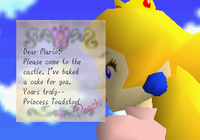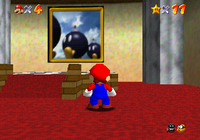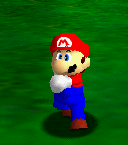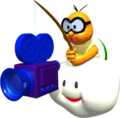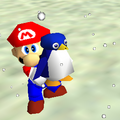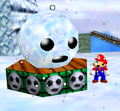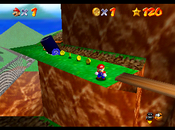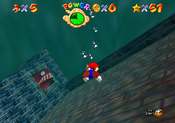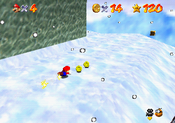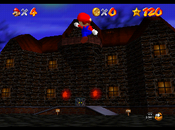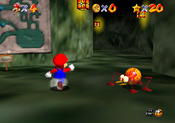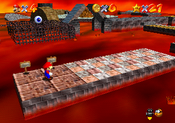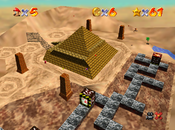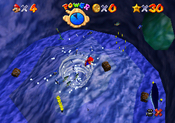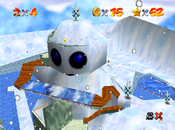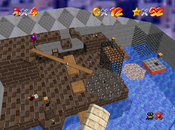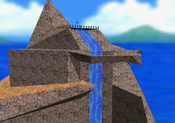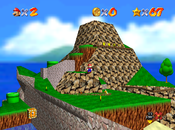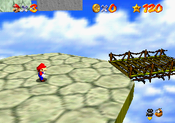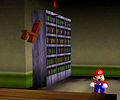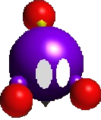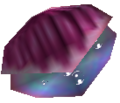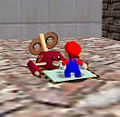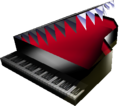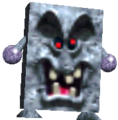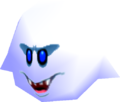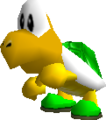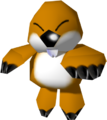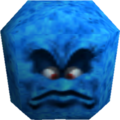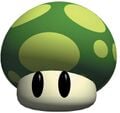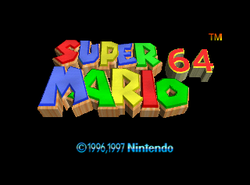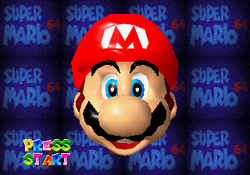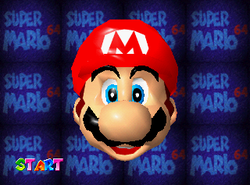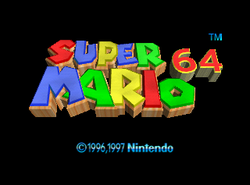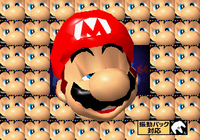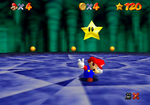Super Mario 64
Template:Infobox Super Mario 64 is a 3D action-adventure platformer game released for the Nintendo 64 in 1996. This game was one of two (three in Japan) launch titles for the Nintendo 64, along with Pilotwings 64, which helped drive initial sales of the console. As of January 7, 2017, it has sold over 11 million copies worldwide[1], and is marked as the best selling Nintendo 64 game of all time. It is also the second most popular game on the Wii's Virtual Console, after Super Mario Bros.
Being the first 3D Mario game, Super Mario 64 has introduced many moves that would be used in almost every later Super Mario title: Triple Jumping, Ground Pounding, Long Jumping, Diving, and Somersaults. Punching and kicking were also introduced, but would not be used in any later main titles (besides its DS remake).
Though not the first 3D platforming game, Super Mario 64 codified many of the controls and designs conventions of the genre[2]. It is widely acclaimed as one of the greatest and most important games of all time[3][4][5].
In 1996, there was a Nintendo 64DD disk version of the game shown at Shoshinkai 1996.[6] In 2004, a remake of Super Mario 64 was released for the Nintendo DS entitled Super Mario 64 DS. The remake had various differences from the original game such as Luigi, Yoshi, and Wario becoming playable characters. There was also a sequel called Super Mario 64 2 planned for the Nintendo 64DD, but it was canceled due to the 64DD's commercial failure.
Super Mario 64 was rereleased digitally on the Wii's Virtual Console service on November 19, 2006, and again on the Wii U's Virtual Console service on April 1, 2015, making it and Donkey Kong 64 the first two Nintendo 64 games to be released on the Wii U.
Super Mario 64 was the first time that many players heard Charles Martinet as Mario's voice, as it is today. The game also named Princess Toadstool as Peach, as shown in the opening letter, and made it a series standard.
Storyline
The following is the story given on pages 4 and 5 of the Super Mario 64 instruction booklet. The colors given in the instruction booklet signify who is talking: Mario, hotpink, orange, and red, with black being narration.
hotpink
blue
Mario is so excited to receive the invitation from the Princess, who lives in the Mushroom Castle, that he quickly dresses in his best and leaves right away.blue
Shaking off his uneasy premonition, Mario steps into the silent castle, where he is greeted by the gruff words,orange
The sound seems to come from everywhere.blue
Mario begins searching all over the castle. Most of the doors are locked, but finding one open, he peeks inside. Hanging on the wall is the largest painting he has ever seen, and from behind the painting comes the strangest sound that he has ever heard...blue
Without a second thought, Mario jumps at the painting. As he is drawn into it, another world opens before his very eyes.And so begins the grandest of all adventures!
Once inside the painting, Mario finds himself in the midst of battling Bob-ombs. According to the Bob-omb Buddies, someone...or something...has suddenly attacked the castle and stolen the "Power Stars". These stars protect the castle; with the stars in his control, the beast plans to take over the Mushroom Castle.
To help him accomplish this, he plans to convert the residents of the painting world into monsters as well. If nothing is done, all those monsters will soon begin to overflow from inside the painting.
blue
Princess Toadstool and Toad are missing, too. Bowser must have taken them and sealed them inside the painting. Unless Mario recovers the Power Stars immediately, the inhabitants of this world will become Bowser's army.blue
Stolen Power Stars are hidden throughout the painting world. Use your wisdom and strength to recover the Power Stars and restore peace to the Mushroom Castle.red
Gameplay
The player controls Mario in a variety of open environments of varying size and complexity, ranging from a small cubic room to large self-contained worlds populated by enemies, items, and friendly NPCs who can either provide limited assistance to Mario or are subject of one of the game's tasks.
To progress, the player must collect Power Stars by completing a variety of missions, ranging from tasks such as defeating a specific enemy, completing a puzzle, collecting a set amount of items, or besting a NPC in a friendly competition. There are a total of 120 Power Stars in the game, though only 70 need to be collected in order to complete the game. The Power Stars are split between the fifteen main courses, nine secret courses, and other objectives. The main courses contain six numbered missions each plus a hidden Power Star for collecting 100 coins. Though missions for a level are numbered, most missions can be performed out of order. Other missions, however, can only be completed by selecting a specific scenario from the course selection screen, as to prompt the appearance or disappearance of a character or object needed to complete the task.
The game is primarily set inside and around Princess Peach's Castle, itself divided in multiple rooms containing portals (most represented as paintings) that lead to the game's courses. Initially, the player can only access one of the paintings and a limited section of the castle, but as the player collects Power Stars, the player will be able to unlock doors leading to the other courses and open up other sections of the castle by collecting a certain number of stars and completing a Bowser level.
Controls
Super Mario 64 uses a majority of the buttons on the Nintendo 64 controller, the only buttons not used are the Control Pad and the Button.
 - Move Mario/cursor, climb poles, angle camera in second-person mode, fly (when wearing the Wing Cap)
- Move Mario/cursor, climb poles, angle camera in second-person mode, fly (when wearing the Wing Cap) - Jump, swim, confirm
- Jump, swim, confirm - Punch, Dive, grab, throw, cancel
- Punch, Dive, grab, throw, cancel - Crouch
- Crouch ,
,  - Move Camera
- Move Camera - Zoom in, enter second-person mode (which allows the player to look around)
- Zoom in, enter second-person mode (which allows the player to look around) - Zoom out
- Zoom out- Toggle camera mode
 - Pauses the game, activates Star List (when in Peach's Castle) or pause menu (when in courses)
- Pauses the game, activates Star List (when in Peach's Castle) or pause menu (when in courses)
Additional Moves
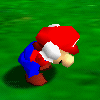
To get around the courses in the game, Mario has to make use of several moves. Along with the standard moves listed above, there are several additional moves that can be done by using button combinations. A "->" implies combinations where buttons need to be pressed in succession, and a "+" implies combinations where buttons need to be pressed simultaneously.
 ->
->  - Double Jump
- Double Jump ->
->  ->
->  (while running) - Triple Jump
(while running) - Triple Jump ->
->  ->
->  (while wearing the Wing Cap) - Take off
(while wearing the Wing Cap) - Take off (after quickly turning around while running) - Sideways Somersault
(after quickly turning around while running) - Sideways Somersault (after hitting a wall) - Wall Jump
(after hitting a wall) - Wall Jump ->
->  - Jump Kick
- Jump Kick ->
->  (while running) - Midair Dive
(while running) - Midair Dive ->
->  - Ground Pound
- Ground Pound ->
->  ->
->  - Punch, Punch, Kick
- Punch, Punch, Kick +
+  - Backwards Somersault
- Backwards Somersault +
+  (while running) - Long Jump
(while running) - Long Jump +
+  - Sweep Kick
- Sweep Kick +
+  (while running) - Slide Kick
(while running) - Slide Kick +
+  - Crawl
- Crawl
Characters
Main Characters
- Mario64smile.jpg
- Princess Peach Super Mario 64.png
Supporting Characters
- Penguin.jpg
- 64bigpenguin.PNG
- Super Mario 64 Rabbit.PNG
Courses
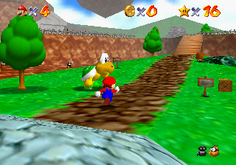
Levels are laid out inside paintings in the castle, or sometimes the walls themselves. They can also be found in holes, portals, oil pits, and inside a clock. Each world has seven Power Stars. Within each, one of which is gained by finding one hundred coins in the level. The other six Power Stars are found by performing "missions", accomplished by fighting bosses, winning races, etc. Every course has boundaries to limit the player from going too far, either as a strict wall or an invisible boundary.
Castle Secret Stars
In addition to the main courses of the game and the Bowser Courses, there are also a few hidden courses that house several of the Castle's Secret Stars, as well as the three ! Switches.
- The Princess's Secret Slide (2 Stars)
- The Secret Aquarium (1 Star)
- Bowser in the Dark World (1 Star)
- Toads' Stars (3 Stars)
- Tower of the Wing Cap (Wing Cap) (1 Star)
- Cavern of the Metal Cap (Metal Cap) (1 Star)
- Vanish Cap Under the Moat (Vanish Cap) (1 Star)
- MIPS (2 Stars)
- Bowser in the Fire Sea (1 Star)
- Wing Mario Over the Rainbow (1 Star)
- Bowser in the Sky (1 Star)
Three of the Toads in the castle give the player a Power Star when talked to. One of the Toads is in a corner near the entrance to Hazy Maze Cave, another is under the staircase on the second floor, and the third is to the right of Tick Tock Clock.
Enemies
New Enemies
- Bully64.jpg
- Sm64pyroblock.jpg
- Grindel64.jpg
- Klepto.jpg
- Mr I.PNG
- Toxboxsides.PNG
Returning Enemies
Bosses
There are various mini-bosses in some stages, but the primary boss is Bowser. He appears three times in three different levels. This is a list of the bosses in the game.
| Image | Description |
|---|---|
 Big Bob-omb |
A giant Bob-omb in Bob-omb Battlefield. He appears as the first boss in the game and the first star. |
 Whomp King |
A giant Whomp on top of Whomp's Fortress. He appears as the first star, and after he is defeated, there is a tower on top of the fortress. |
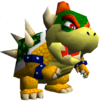 Bowser |
Bowser appears in Bowser in the Dark World, Bowser in the Fire Sea (where the arena tilts), and Bowser in the Sky (where he must be thrown three times). The player needs to swing him by the tail clockwise or counterclockwise and hurl him at bombs on the outside of his circular arena. |
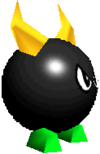 Big Bully |
Two of these giant Bullies appear in Lethal Lava Land. On both occasions, they try to knock Mario into the lava. |
Eyerok |
Two stone hands with eyes on their palms. They appear when the player blasts open the top of the Pyramid in Shifting Sand Land and rides the elevator inside. |
 Big Boo |
A giant Boo which appears three times in Big Boo's Haunt. He initially appears once all the Boos in the mansion have been removed, again in the underground Merry-Go-Round, and lastly on the top balcony of the mansion. |
 Big Mr. I |
A giant Mr. I which only appears in the attic of Big Boo's Haunt. |
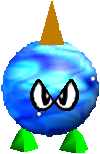 Chill Bully |
A large Bully made of ice. He tries to ram Mario onto a lethally frozen pond in Snowman's Land. |
 Wiggler |
A giant Wiggler, which becomes angry when his home in Tiny-Huge Island gets flooded. |
Items
Throughout the game, the player can make use of several items. Some items are out in the open, whereas others are found by breaking open ! Blocks or completing challenges.
| Image | Description | Image | Description |
|---|---|---|---|
| File:SM64 Yellow Coin.png Coin |
A standard Coin found in the levels. When collected, it restores one point of Mario's Health Meter. | 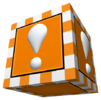 ! Block |
A floating block that holds either coins, 1-Up Mushrooms, or Power Stars. |
| File:Sm64redcoin.png Red Coin |
A red variant of the Yellow Coin, each worth two coins. Eight are scattered around most courses, and collecting them all will cause a Power Star to appear. They restore two points of Mario's Health Meter when collected. | File:Wingcapblock.jpg Red ! Block |
A red ! Block that holds a Wing Cap. Will become solid once the Red ! Switch is pressed. |
 Blue Coin |
A blue variant of the Yellow Coin, each worth five coins. They usually appear after Ground Pounding Blue Switches or after defeating stronger enemies like a Mr. I. | File:Vanishcapblock.jpg Blue ! Block |
A blue ! Block that holds a Vanish Cap. Will become solid once the Blue ! Switch is pressed. |
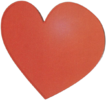 Spinning Heart |
A large heart than spins when Mario walks through it, which will recover his Health. The amount of Health it recovers and how fast it does so is dependent on how quickly Mario moves through it. | File:Metalcapblock.jpg Green ! Block |
A green ! Block that holds a Metal Cap. Will become solid once the Green ! Switch is pressed. |
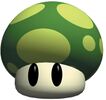 1-Up Mushroom |
A green spotted Mushroom that will give Mario an Extra Life when collected. | 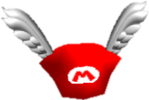 Wing Cap |
Once collected from a Red ! Block, the Wing Cap allows Mario to fly for a limited time. |
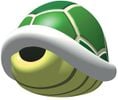 Shiny Shell |
A shell from a Koopa Troopa that Mario can ride, defeating enemies he runs over and allows him to move around the course quicker. Pressing |
File:SM64 VanishCap.JPG Vanish Cap |
Once collected from a Blue ! Switch, the Vanish Cap turns Mario invisible, allowing him to pass through wired cages and ignore enemies. |
| File:Powerstar64.png Power Star |
The main objective of the game. Collecting enough of them will allow Mario to open up doors. |  Metal Cap |
Once collected from a Green ! Switch, the Metal Cap turns Mario into metal, allowing him to walk underwater and defeat small enemies by simply running into them. |
Notable mistakes and errors
- At the end of the game, when speaking to Yoshi on the castle roof, Yoshi says "Mario!!! It that really you???" instead of "Mario!!! Is that really you???".
- If Mario is one star short of opening a door, it will still refer to the word needed in the plural: "You need 1 more stars" instead of "You need 1 more star."
Those errors remained in the Virtual Console version. However, they were fixed in the remake, as Yoshi is a playable character, and the message that appears when Mario doesn't have enough stars to open a door is "You need (number) more."
References to other games
- Super Mario Bros. - A carving of Mario and a carving of Bowser from this game appear on a pillars in Bowser in the Sky. An arrangement of the overworld theme plays on the title screen, and the underground theme can be heard in the music for Hazy Maze Cave and Wet-Dry World. There is also a small jingle used at the Power Star select screen which sounds identical to the first few notes of the overworld theme in this game.
- Super Mario World - The idea of Switch Palaces is, in a way, brought back. Also, when Yoshi is met, he says to Mario "It has been so long since our last adventure!", referring to this game. Also, the soundtrack follows the same composition technique used in Super Mario World in a similar way where there's a signature melody in the game that's heard across different levels in several variations (Bob-omb Battlefield, Snow Mountain, Slider).
- Super Mario World 2: Yoshi's Island - The theme used for invincibility in this game, specifically the string instruments playing in the background, is reworked into Wing/Vanish Mario's theme for Super Mario 64. The idea of collecting Red Coins first appeared in this title as well.
- Hotel Mario - The sound effect warp1.wav (which typically plays when entering a Bowser course) is reused from one of this game's cutscenes.[7]
References in later games
- Donkey Kong Country 3: Dixie Kong's Double Trouble! - Wrinkly Kong plays this game sometimes in her Save Caves. The theme for Wrinkly's Save Cave is also very similar to "Inside the Castle Walls," the music for Princess Peach's Castle.
- Mario Kart 64 - Peach's Castle is hidden on Royal Raceway and its appearance is identical to its design in Super Mario 64. The castle grounds are also there and unchanged between the two games. The drawback is the castle is inaccessible. Penguins in Sherbet Land have an identical appearance and come in various sizes.
- Super Smash Bros. - Most of Mario's moves, animations and voice clips in this game are derived from the ones in Super Mario 64. Metal Mario appears as a boss. Two levels based on places here are also accessible, such as Metal Mario's stage and Peach's Castle. Although Luigi didn't appear in the game, his moves, animations and voice clips are identical to Mario's in Super Mario 64, except Luigi's voice clips are higher-pitched versions of Mario's.
- Paper Mario - This game starts the same way, with a letter being sent from Peach. Peach's Castle returns and the main room is near identical (however, the doors do lead to different rooms).
- Mario Party - The board Mario's Rainbow Castle is based on the secret course Tower of the Wing Cap. Mario's title screen (if he wins the board game under the title of being a Superstar) depicts him with the Wing Cap flying with the other playable characters.
- Mario Kart: Super Circuit - Princess Peach's Castle reappears in the background of Peach Circuit, Mario Circuit 1 and Mario Circuit 4. The music for the Bowser Castle courses is a sped-up arrangement of Bowser's battle theme from this game.
- Super Smash Bros. Melee - Two stages based on areas from Super Mario 64 appear: Princess Peach's Castle (which also appears as a trophy) and Rainbow Ride. Metal Mario reappears as a boss and a trophy. Additionally, the Metal Box returns in this game as an item and a trophy. Mario still has his voice clips, moves, and animations and Luigi still has Mario-like voice clips, moves, and animations. One of Kirby's Stone forms is based on the Thwomp's design first used in this game.
- Super Mario Sunshine - A brief clip of Mario's fight with Bowser is seen when F.L.U.D.D. scans Mario.
- Mario & Luigi: Superstar Saga - In Woohoo Hooniversity, a room with four blocks can be seen in it; one of them is a block from Super Mario 64. The name of the game is even mentioned in the description of the blocks, and the professors are trying to figure out why it vanishes when struck.
- Paper Mario: The Thousand-Year Door - The game starts in the same way, Peach sends Mario another letter.
- Mario Power Tennis - The music that plays during the minigame Artist On the Court is an arrangement of "Inside the Castle Walls."
- Super Mario 64 DS - This game is a remake of Super Mario 64. Also, at the start, Yoshi is on the roof and jumps down, a reference to the fact that he is there at the end of Super Mario 64.
- Mario Kart DS - Tick Tock Clock appears as a race track in this game. Several bosses found here also reappear in this game.
- Mario & Luigi: Partners in Time - The theme for Princess Peach's Castle is a cover version of this game's castle theme. Also, ! Blocks appear in this game.
- New Super Mario Bros. - This game uses many things found here, such as Dorrie, and a Bowser head closes in on the screen when the player dies. Also, the Wing/Vanish Cap theme is present for Invincibility in this game.
- Mario Strikers Charged - A cover of the music that plays in Big Boo's Merry-Go-Round is featured in this game, as the theme associated with Boo sidekicks.
- Super Mario Galaxy - The game starts in the same way, with Peach sending Mario another letter. Also, "Bowser's Road" is covered for Bowser's Star Reactor and Bowser's Dark Matter Plant. Also, the falling asleep idle animation returns.
- Super Smash Bros. Brawl - Music from Bob-omb Battlefield is unlockable, and the Rainbow Ride stage and Metal Box from the previous game return as well. Mario retains the moves and animations that originated in Super Mario 64.
- Mario Super Sluggers - Both songs that play when playing in Peach Ice Garden and going into said place in Challenge mode are arrangements of the music for Princess Peach's Castle from this game.
- Mario & Luigi: Bowser's Inside Story - The music for when the Mario Bros. first enter Princess Peach's Castle and when everyone is removed from Bowser's Belly is a cover of the Peach's Castle theme. Also, both games end in a view of a cake with Mario and Peach figures on it.
- Mario & Sonic at the Olympic Winter Games - Cool, Cool Mountain's and Snowman's Land's music is covered for the Dream Snowball Fight event in this game. The main theme and the Bowser stage theme is also used.
- New Super Mario Bros. Wii - Princess Peach's Castle reappears in the game. Winning a Toad House minigame plays the jingle heard after exiting a course with a Power Star, and when revealing a pair of Bowser or Bowser Jr. icons in the Power-up Panels minigame, the short tune that plays when trying to enter a locked door is heard.
- Super Mario Galaxy 2 - In both Tall Trunk Galaxy (during the mission "Tall Trunk's Big Slide") and Rolling Coaster Galaxy, an arrangement of The Princess's Secret Slide's music plays at a moment. Also, the Whomp's Fortress reappears as the Throwback Galaxy, alongside Bob-omb Buddies and the Whomp King. Both games start with Peach sending a letter to Mario. Also, an orchestral cover of "Bowser's Road" can be heard in Bowser's Lava Lair and Bowser's Gravity Gauntlet.
- Super Mario 3D Land - The sound effect of Mario falling from heights is reused, plus the platforming style is mixed together with Super Mario Bros. 3 and Super Mario Galaxy. Also, when the player waits outside a purple Mystery Box on the map screen, the Endless Stairs music from Super Mario 64 can be heard.
- Mario Kart 7 - Metal Mario appears as a playable character.
- Mario Tennis Open - A cover of the music for Princess Peach's Castle is used for Peach's Palace. On the Bowser's Castle court, a cover of the Bowser battle music is played.
- New Super Mario Bros. 2 - The first few notes of the theme for Princess Peach's Castle are played during the intro.
- Paper Mario: Sticker Star - The music for The Princess's Secret Slide is covered during the minecart part of Bowser's Snow Fort.
- Super Mario 3D World - A cover of The Princess's Secret Slide's music plays when riding Plessie. In Shifty Boo Mansion, a level in Super Mario 3D World, there is a Green Star hidden behind a portrait of a Boo that can be entered like the pictures in Princess Peach's Castle.
- Mario Kart 8/Mario Kart 8 Deluxe - The merry-go-round music from Big Boo's Haunt can be heard near the Aqua Cups ride in Water Park.
- Mario Party: Island Tour - A cover of "Koopa's Road" plays in Bowser's Peculiar Peak.
- Super Smash Bros. for Nintendo 3DS / Wii U - Peach's Castle (64) appears a DLC stage, which returns from the original Super Smash Bros. In Super Smash Bros. for Wii U, the original version of the main theme returns, and an arranged version of the theme is featured in the DLC stage in both games.
- Super Mario Maker - The victory theme and the Game Over theme are used when the Mario, Silver Mario, and Gold Mario costumes complete a level or lose a life, respectively. Additionally, when a Super Star is obtained, the Wing Cap theme is played for the Mario costume and the Metal Cap theme is played for the Silver Mario and Gold Mario costumes.
- Mario & Luigi: Paper Jam - King Bob-omb reappears as a boss in this game.
- Super Mario Odyssey - The game marks a return to the non-linear, open-ended style of gameplay for 3D Mario platformers established by this game. An arrangement of Bowser's theme can be heard in the song "Break Free (Lead the Way)". The Mushroom Kingdom is filled with many references to Mario's past, mostly Super Mario 64. Its regional currency also resemble the coins from Super Mario 64. Additionally, Mario can dress up as the original Super Mario 64 model of himself by buying the hat and costume separately at the Mushroom Kingdom Crazy Cap shop. Also, the Metal outfit is just the Super Mario 64 suit, but with a metal coat. The jingle that plays when collecting a Power Moon is an arrangement of the jingle that plays when collecting a Power Star in Super Mario 64. Also, the brochure held by Hint Toad and in the Odyssey depicts Bob-omb Battlefield.
Media
- For a complete list of media for this subject, see List of Super Mario 64 media.
Reissues
- Main article: Super Mario 64 DS
Super Mario 64 DS is the remake of the game for the Nintendo DS, bearing some new features on its storyline, gameplay and graphics. Unlike Super Mario 64, Mario is not the only playable character (nor is he even available at the start, the only character available at the start of the game is Yoshi); Yoshi, Luigi, and Wario also join the adventure in order to rescue Princess Toadstool from the hands of Bowser. Other new features within the game include a multi-player mode, in which up to four players can play simultaneously on each Nintendo DS connected together locally; minigames to play with each character, and new additions to the story mode such as new missions and levels.
A version of the original game was released in Japan on July 18, 1997, that included Rumble Pak support. This game is the same as the International release of the game, as it retains all of the glitch fixes as well as graphical and sound changes (except Mario calling Bowser by his name in the "So long-eh Bowser" voice clip, which was changed to "buh-bye"). The only differences other than one voice clip are the language being changed back to Japanese, a new title screen easter egg, fixing of the "backwards long jump" glitch and the Rumble Pak support.
Official soundtrack
- Main article: Super Mario 64 Original Soundtrack
An original soundtrack that is based on the game is released. It has thirty-six tracks from the game.
Gallery
- For this subject's image gallery, see Gallery:Super Mario 64.
- Bowsersm64.gif
Bowser
- Sm64 the big boo.png
Boo
- Powerstar64.png
Power Star
Version differences
There are a total of four Nintendo 64 releases of Super Mario 64: The original Japanese version, the North American release, the European and Australian release, and the Japanese Super Mario 64: Shindō Pack Taiō Version re-release.
Changes to the North American release
Text changes
- The script is exclusively in English.
- Princess Peach signs her letter with a large, pink "Peach". In the Japanese release she signs her letter in normal sized black text.
Audiovisual changes
- The entrance to Jolly Roger Bay is changed. In the original release, it is a painting of bubbles in a blue frame. In the North American release, it is a painting of a sunken ship in a gold frame.
- In the Japanese version, the animation that plays when Mario collects a key after defeating Bowser depicts him dancing with a Power Star, as he does after completing a Power Star mission in all versions of the game. In the North American release, this is changed to a new animation in which Mario dances with the key itself.
- The unused "key" HUD icon is removed from this version. It is replaced with a corrupted graphic.
- The J, Q, V, Z, %, &, !, and ‼ characters are removed from the game's multicolored font, and replaced with corrupted graphics similar to the key. None of these symbols are actually used anywhere in the game.
- The Chain Chomp's bark has been changed to a completely different sound.
- The Red Coin sound effect increases in pitch with each coin collected. In the Japanese release, all red coins make the same sound.
- The intro cutscene has several additional sound effects not present in the original release:
- The blowing of wind when Lakitu is flying.
- The click of the camera shutter when the in-game camera moves to Lakitu's perspective.
- The spring sound and voice line "Ha ha!" when Mario jumps out of the pipe.
- A sound effect not present in the Japanese game plays when mario exits a course through the pause menu.
- When entering certain substages, such as Tower of the Wing Cap, the Power Star collection sound effect plays.
- When Lakitu appears to explain things to Mario, a short tune entitled "Lakitu's Message" plays. Since this tune is not in the original Japanese release, it isn't found on the official soundtrack.
- The North American release adds more voice acting for Mario:
- "Hello!" when Mario's face greets the player on the title screen.
- "Okey-dokey!" when the player chooses a save file.
- "Let's-a go!" when the player chooses a star before entering a course.
- "Game over!" when the player runs out of lives.
- "Press START to play!" during the title screen demo.
- "Boing!" when the player jumps off a Spindrift.
- "I'm-a tired!" and the names of various pastas when Mario is sleeping.
- "Mamma mia!" when falling out of a non-painting course after the player loses a life.
- In the original Japanese version, Mario says "Here we go!" when he throws Bowser. In the North American version, he only says "Here we go!" when throwing Bowser a short distance. When he throws Bowser a long distance, he instead says "So long, King Bowser!".
- Similarly, when Mario hits a wall in the Japanese version, he grunts. In the North American version, Mario grunts if he hits a wall at a low speed, but says "D'oh!" if he Long Jumps or dives into a wall.
- When Mario Triple Jumps in the Japanese release, he says "Yahoo!". In the North American release, he randomly says any of "Yahoo!", "Wha-ha!", or "Yipee!".
- All of Princess Peach's voice acting is new in this version of the game.
Fixed glitches
- When Mario steps on one of the Cap Switches, a text box is triggered that explains the function of the switch. In the Japanese release, this text box causes the action in-game to pause until the text box is closed. If a Power Star is collected before this text box appears, the star will not vanish as it is supposed to do upon collection. In the American release, the text box does not cause the action to pause, which fixes this glitch.
- If 1000 coins are collected, the coin counter is intended to immediately set itself back to 999 coins. In the Japanese release, it instead sets the life counter to 999. Because the life counter is stored in memory as a one byte wide signed field, this causes an overflow, and Mario's life total becomes -25. The North American release correctly sets the coin counter to 999, rather than the life counter.
- The first two times Bowser is defeated, he leaves behind a key. If Mario is standing where the key will land and the player presses
 to activate the first person camera, Mario will keep looking that way during the key collection cutscene.
to activate the first person camera, Mario will keep looking that way during the key collection cutscene. - In Shifting Sand Land's pyramid, collecting the fifth secret may cause the audio to stop playing. If this happens, attempting to leave the course in any way will trigger a game crash.
- If Mario exits a course while standing on a moving platform, he will retain his momentum when Peach's Castle loads. This will cause Mario to spawn in an abnormal location.
Level design changes
- In the mission Blast to the Stone Pillar, the Power Star is in an ! Block, rather than in the open as it was in the Japanese release.
- In the mission Li'l Penguin Lost, the Power Star's spawn location has been moved from directly above the Mother Penguin to an empty area adjacent to her. This was apparently done because the penguin's hit box made it difficult to collect the star in its original location.
Changes to the European and Australian release
These releases feature all the changes of the North American release, plus the following additional changes:
Text changes
- The script can be switched between English, German, and French.
- The North American version's "Sound" menu has been renamed to "Options", reflecting the fact that the in-game language can be changed from this menu.
- The characters Ä, Ö, and Ü have been added to the multicolored font, to allow proper representation of the German language. The Ü character is not actually used anywhere in the game. V and Z, which are present in the Japanese release but changed to corrupted characters in the North American release, are restored in this edition of the game
Audiovisual changes
- The copyright date on the title screen is changed to reflect the release year of the European and Australian editions. The trademark symbol was changed for unknown reasons. The Logo is slightly narrower.
- The intro screen says "PRESS START" in the NTSC versions, but just "START" in the PAL version. The text was also moved slightly to the left in the PAL version.
- The NTSC versions have slight letterboxing while the PAL version does not. This is most noticeable with the gap between the edge of the HUD elements and the edge of the screen.
- In the intro, Mario jumps out of a pipe and a variation on the classic Mario pipe sound effect plays. In this edition of the game, the sound effect plays at a much quieter volume.
- The sound of a Big Star Door closing is now more similar to the sound of the door opening.
- The yellow coin collecting sound is slightly slowed down.
- The sound effect of grabbing and then releasing Mario's face on the title screen is changed.
- Mario's Double Jump sound is different.
Gameplay Changes
- This version of the game outputs a signal compatible with the PAL television standard, rather than the NTSC standard used by the North American and Japanese releases. Therefore, it outputs 25 frames per second instead of 30. This causes everything in the game to happen at 5/6ths of the speed that it happens in the North American release.
Changes in Super Mario 64: Shindō Pack Taiō Version
This release features all the changes of the North American release, plus the following additional changes:
Text changes
- The original Japanese script is restored.
- Text that mentioned pressing
 to read signs in both the original Japanese and localized scripts now additionally mentions
to read signs in both the original Japanese and localized scripts now additionally mentions  can be pressed as an alternative.
can be pressed as an alternative.
Audiovisual Changes
- The copyright date on the title screen is updated to reflect the release date of Super Mario 64: Shindō Pack Taiō Version. The trademark symbol is changed.
- A notice in the lower right corner of the intro screen informs players that this release is compatible with the Rumble Pak.
- If the player presses
 on the intro screen, the background will be filled with images of Mario's face. These faces are copied from the frame buffer, so they move in synchronisation with the the modeled Mario face.
on the intro screen, the background will be filled with images of Mario's face. These faces are copied from the frame buffer, so they move in synchronisation with the the modeled Mario face. - The voice line "So long-a Bowser" is changed to "Buh-bye!", since Bowser's name is Kuppa in Japan.
- Mario's Double Jump sound a higher pitched version of the same sound from the European and Australian version.
- One of Mario's single Jump sounds is higher-pitched.
Gameplay Changes
- The game is compatible with the Rumble Pak.
Pre-release and unused content
- Main article: List of Super Mario 64 pre-release and unused content
One unused asset is the Blargg, which is still in the game's data, that would've appeared in the Lethal Lava Land, Bowser in the Fire Sea, and Wing Mario over the Rainbow stages. Also, Big Boo held a key instead of a Star inside of him. The purpose of the keys was to unlock a variety of the various doors in Big Boo's Haunt - there was even a "key counter". 32 levels were planned for the game, but only fifteen of them made it into the final product.
Reception
It has been requested that this section be rewritten and expanded to include more information. Reason: include a table
Super Mario 64 received critical acclaim, garnering a score of 9.8 from IGN, 9.4 from GameSpot, and 9.75 from Game Informer. Although it was criticized for its camera system and difficulty, it was praised for its graphics, level design, soundtrack, and the Mario series shift from 2D to 3D.
Sometime after the game's release, rumors about secret glitches, stars, and hidden characters circulated. Among the most famous is the widely publicized hoax that Luigi was hidden and fully playable, causing bogus rumors to circulate on how to unlock him.
Super Mario 64 is the best selling game for the Nintendo 64, selling 11.62 million copies worldwide, as of December 31, 2009.
Glitches
- Main article: List of Super Mario 64 glitches
A famous glitch is the Backwards Long Jump, which will let the player slide upward on any staircase, including the Endless Stairs. Another famous glitch is the Black Room of Death, which traps the player behind the boundaries of the castle walls. It could be achieved using several ways, including using the Backwards Long Jump glitch. Another rather known glitch is the cloning glitch, often used to collect more coins than the actual number of coins in the game.
As in many other N64 titles, the cartridge can be tilted in the console to achieve messed up results, for example Mario's body will flip horizontally, but he can still be controlled. Also, the music will be heavily corrupted.
In the Japanese in multiple areas of the game, there are unintended invisible walls that the player can bump into. An example is the one in Tall, Tall Mountain just above the wooden log.
While collecting one of Bowser's keys, if the player can press ![]() and looks somewhere, Mario will keep looking that way during the key collection cutscene.
and looks somewhere, Mario will keep looking that way during the key collection cutscene.
Using a good timed Triple Jump on the slope near the castle, the player can climb the castle without the cannon. Also, when Mario reaches a corner, he can fall down slightly and grab onto a ledge. The player can then pull themselves back up onto the roof, at which point Mario will lose a life. For unknown reasons, he also loses his hat.
Angled Dive
When Mario enters the water, the angle Mario was facing before entering is preserved in a datum, therefore, when the player jumps and lands on dry land, the next dive Mario performs will start with this angle. A few frames afterward, the angle will fix itself and the dive will be completed correctly. Several things "reset" the angle, including grabbing a ledge, shooting from a cannon, changing areas and jumping while facing a slope. This glitch does not affect the dive itself, just the animation.
Staff
- Main article: List of Super Mario 64 staff
Game director
- Shigeru Miyamoto
Assistant directors
- Yoshiaki Koizumi
- Takashi Tezuka
Mario face programmer
- Giles Goddard
Course designers
- Kenta Usui
- Naoki Mori
- Yoshiki Haruhana
- Makoto Miyanaga
- Katsuhiko Kanno
Names in other languages
| Language | Name | Meaning | Notes |
|---|---|---|---|
| Japanese | スーパーマリオ64[?] Sūpā Mario Rokujūyon |
Super Mario 64 | |
| Chinese | 超级马里奥64 Chāojí Mǎlǐ'ào 64 神游马力欧 Shényóu Mǎlì'ōu[?] |
Super Mario 64 (unofficial in China) iQue Mario (name of iQue's localization of Super Mario 64 in mainland China) |
Trivia
- Super Mario 64 was one of the games featured at The Art of Video Games exhibition at the Smithsonian American Art Museum in 2012.[8] The game won voting in the "action" category for the Nintendo 64, beating out Banjo-Kazooie and Star Wars: Shadows of the Empire.
- Like most Nintendo 64 games at the time, Super Mario 64 does not use the full 64-bit capabilities of the console, but actually runs in 32-bit.
- The music which plays while climbing the endless staircase is a Shepard tone, a sequence of notes which are made to sound as if they are infinitely ascending in tone when in fact they are looping.
- Super Mario 64 is one of the few mainstream Mario games, along with Super Mario Sunshine, to not have a single reference to Luigi. However, he is playable in the game's DS remake.
References
- ^ http://www.vgchartz.com/game/2278/super-mario-64/
- ^ GameSpot - 15 Most Influential Games of All Time
- ^ GameFaqs - The top 10 games Ever
- ^ Edge Online - The 100 Best Games to Play Today
- ^ Official Nintendo Magazine - 100 Best Nintendo Games
- ^ http://gamingafterhours.com/2014/06/24/super-mario-64dd-version-discovered-in-japan/
- ^ https://twitter.com/ChocoPain_/status/918890813047926784
- ^ http://americanart.si.edu/exhibitions/archive/2012/games/#games
External links
| Nintendo 64 games | ||
|---|---|---|
| Super Mario franchise | Super Mario 64 (1996) • Mario Kart 64 (1996) • Mario no Photopi (1998) • Mario Party (1998) • Mario Golf (1999) • Mario Artist: Paint Studio* (1999) • Mario Party 2 (1999) • Mario Artist: Talent Studio* (2000) • Mario Artist: Communication Kit* (2000) • Mario Tennis (2000) • Paper Mario (2000) • Mario Artist: Polygon Studio* (2000) • Mario Party 3 (2000) • Dr. Mario 64 (2001) | |
| Donkey Kong franchise | Diddy Kong Racing (1997) • Donkey Kong 64 (1999) | |
| Yoshi franchise | Yoshi's Story (1997) | |
| Crossovers | Super Smash Bros. (1999) | |
